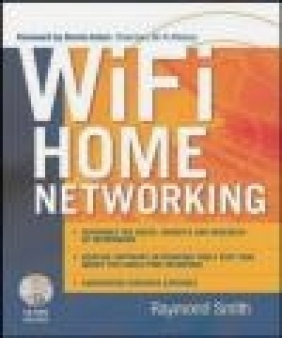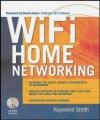Wi-Fi Home Networking
Raymond Smith, Smith
Wi-Fi Home Networking
Raymond Smith, Smith
- Producent: McGraw-Hill
- Rok produkcji: 2003
- ISBN: 9780071412537
- Ilość stron: 347
- Oprawa: Miękka
Niedostępna
Opis: Wi-Fi Home Networking - Raymond Smith, Smith
This book: describes the costs, benefits and necessity of networking; reviews software networking tools that save money for small-time operators; summarizes business expenses and savings to help a prospective user choose their office setup; offers criteria for deciding on distribution media; compares wireless versus wired connections; and includes important, practical information about security, viruses, and backing up. Booking a new career Ojai man, laid off after 25 years by Verizon, becomes author By Roger Harris, [email protected] For 18 months, Ray Smith had way too much time to smell the pink and red roses growing in his Ojai back yard. Like thousands of other telecommunications workers across the country who were laid off by struggling telecom companies, Smith was out of work. A veteran network engineer with more than 25 years of experience, Smith hated being jobless. He looked for work constantly after being let go by Verizon Communications in January 2001. He made a million phone calls and knocked on a like number of doors. Or so it seemed. Too often he heard the words that every 50-something job hunter learns to hate: "You're overqualified." No nibbles. No offers. "I was desperate," said Smith, 55. So with his back to the wall, Smith tried something new -- he wrote a book. Other than the Christmas letters he writes instead of sending cards, Smith was a novice writer. But he knows computer networking. With the help of a good editor and his patient and supportive wife, Jade, he began writing last June. Six months later, Smith delivered the last pages of WiFi Home Networking to his publisher. In the process, he rediscovered himself and put those pesky out-of-work blues into the closet. Seeing his book on the shelf at Barnes & Noble for the first time was "an out-of-body experience almost," Smith said. "Suddenly, I was somebody again." His book was published by McGraw Hill, one of the largest publishing houses in the country. The 347-page book details how to build a wireless network for your home. WiFi is short for "wireless fidelity," the radio frequency technology used to connect computers. Step by step, Smith outlines everything from the history of WiFi and the benefits of a wireless network to choosing the right equipment and setting up the network. The book, which sells for $29.95 and includes a CD version, is aimed primarily at small-office/home-office users. There are several advantages of a wireless network, said Smith, who found in researching the book that more than 20 million U.S. households have more than one computer. With a WiFi home network, several computers can share the same high-speed wireless Internet connection and the same printer. If you have a laptop computer, you can work anywhere in the house or even the back yard -- because there are no wires to trip over. Wireless networks make it easy to share files between computers and remotely control one computer with another computer. And, homeowners don't have to knock holes in walls like they would when running cable for a wired network. Smith said a wireless network makes working from home easier and more productive. Real estate agents, for example, can connect a WiFi camera to their computer and show out-of-town home buyers photos of houses, and a salesperson could sit in their home office and use the technology to video conference with field engineers. How it happened In the last few months, interest in wireless networking has taken off. In addition to being a useful tool for home offices, wireless networks are cropping up in coffee shops, airports and hotels. "Ray has a real knack of seeing things before they become popular," said Jade, who works for Verizon's DSL division. "... A lot of families have more than one computer, and (WiFi) is a way to get them to talk to each other. It's the next logical step." Although Smith never wrote a book before, his longtime friend David Leathers, a Videography magazine editor and president of Eye Square Productions, a video and film production company in Culver City, didn't hesitate to recommend Smith when McGraw-Hill was looking for a WiFi writer. "I knew he knew the subject matter because he had been directly involved in it a very long time," said Leathers, who has written technical books for McGraw-Hill. "I've not been particularly impressed with some of the technical writing I see. Some of it looks like somebody took some downloads from the Net, some press releases and rescrambled it and then called it an article. But I knew Ray would take it seriously and do original work on it." Smith's serious work-ethic impressed his editor at McGraw-Hill. "He did a great job of researching and getting enough information from the vendors," said Judy Bass, senior editor with McGraw-Hill. Smith accepted criticism without complaint and quickly learned the style preferred by McGraw-Hill's Professional Book Group, which publishes hundreds of titles a year. "He really went out and learned about the market and in the process marketed himself really well," Bass said. Unlike many how-to technical books, Smith writes in a manner understandable by both novices and tech-savvy readers. The book is sprinkled with interesting tidbits. For instance, the first wireless communication was in 1880 when Alexander Graham Bell invented the photophone, which used a beam of light to carry a voice message between buildings in Washington, D.C. The Ventura County Star 20030608Chapter 1: Is This Trip Necessary? At Home in the Twenty-First Century Turning Your Home into a Hot Spot Wireless Wired Interchangeable Parts Roam, Roam on the Range Wi-Fi Building Blocks Chapter 2: From the World to Your Door Into the Fast Lane How to Connect a Broadband Pipe Ma Bell DSL Installing Your DSL Chapter 3: From the Doorstep to the Tabletop Sharing a Broadband Internet Connection Alternatives to Wi-Fi Physical Planning for Your Wi-Fi Home Network Chapter 4: Security and Setup War Dialing Configuring Restricted Access Four Security Fences Workstation File Sharing Firewall Limits Unwanted Bugs: Viruses Setting Up Your Network Chapter 5: Good Housekeeping Maintenance Is a Good Habit Calls for Backup Power Corrupts Uninterruptible Power Supplies (UPSs) Other Maintenance Tasks Bug Patrol Chapter 6: Can You Hear Me Now? Basic Troubleshooting Methods Dealing with the Trouble Desk Common Wi-Fi Problems and Cures Common DSL Problems and Cures Common Cable Broadband Problems Troubleshooting Shoot-em-Ups Chapter 7: Wi-Fi for Fun and Profit So Much Music, So Little Time PC TV Bang! You're Dead Wi-Fi Telephones Wi-Fi as a Tool for the Job Chapter 8: Where No One Has Roamed Before Boingo Wireless NYCwireless Linksys The Wi-Fi Alliance In-Stat/MDR Apple Computer Hewlett-Packard The Last Word: The Author Gazes into His Crystal Ball Chapter 9: Frequently Asked Questions Wi-Fi Networking Uninterruptible Power Supply (UPS) FAQ (Courtesy CyberPower Systems) Glossary Index Glossary Index
Szczegóły: Wi-Fi Home Networking - Raymond Smith, Smith
Tytuł: Wi-Fi Home Networking
Autor: Raymond Smith, Smith
Producent: McGraw-Hill
ISBN: 9780071412537
Rok produkcji: 2003
Ilość stron: 347
Oprawa: Miękka
Waga: 0.75 kg


















